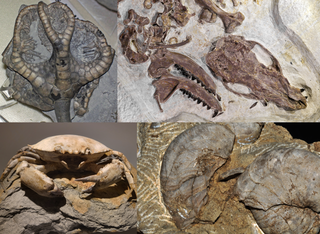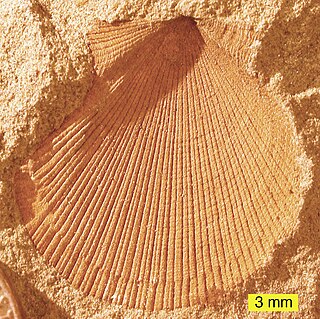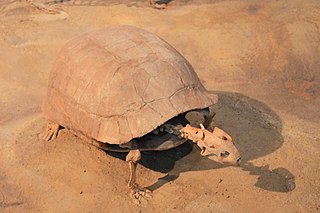
A fossil is any preserved remains, impression, or trace of any once-living thing from a past geological age. Examples include bones, shells, exoskeletons, stone imprints of animals or microbes, objects preserved in amber, hair, petrified wood and DNA remnants. The totality of fossils is known as the fossil record. Though the fossil record is incomplete, numerous studies have demonstrated that there is enough information available to give a good understanding of the pattern of diversification of life on Earth. In addition, the record can predict and fill gaps such as the discovery of Tiktaalik in the arctic of Canada.

A fossil fuel is a carbon compound- or hydrocarbon-containing material formed naturally in the Earth's crust from the buried remains of prehistoric organisms, a process that occurs within geological formations. Reservoirs of such compound mixtures, such as coal, petroleum and natural gas, can be extracted and burnt as a fuel for human consumption to provide energy for direct use, to power heat engines that can propel vehicles, or to generate electricity via steam turbine generators. Some fossil fuels are further refined into derivatives such as kerosene, gasoline and diesel, or converted into petrochemicals such as polyolefins (plastics), aromatics and synthetic resins.

Lontra is a genus of otters from the Americas.

Condylura is a genus of moles that contains a single extant species, the star-nosed mole (Condylura cristata) endemic to the northern parts of North America. It is also the only living member of the tribe Condylurini.

Theriiformes is a clade of mammals. The term was coined by Timothy B. Rowe in his doctoral dissertation, and is defined as the clade formed by the most recent common ancestor of multituberculates and Theria. Mammals more closely related to therians than to multituberculates are included in the clade Trechnotheria. As multituberculates are usually considered more closely related to therians than monotremes are, it is considered to be a subgroup of the mammalian crown group.

Windley Key Fossil Reef Geological State Park is a Florida State Park located at mile marker 85.5 on US 1 near Islamorada. It was a former quarry used by Henry Flagler in the early 1900s to help his building of the Overseas Railroad. Following the railroad's completion, it was a source of decorative stone pieces called Keystone. Now on display are exposed sections of fossilized coral and some of the original quarry machinery. The Hurricane Monument at Mile Marker 82 in Islamorada is constructed of Keystone from the quarry.
Anomalomyidae is a family of extinct muroid rodents from Europe.
The Cypriot mouse is a species of mouse endemic to Cyprus. Its primary habitat seems to be the vineyards and fields of the Troödos Mountains region.
Kromdraai Conservancy is a protected conservation park located to the south-west of Gauteng province in north-east South Africa. It is in the Muldersdrift area not far from Krugersdorp.
The Geological Survey of India (GSI) currently maintains two protected areas bearing rich fossil deposits.
The Lake Macquarie Petrified Forest is a petrified pine tree forest at Fennell Bay, Lake Macquarie, New South Wales, Australia. Geologically it is located in the Permo-Carboniferous strata. The nearest town is Swansea.

Aviculopecten is an extinct genus of bivalve mollusc that lived from the Early Devonian to the Late Triassic in Asia, Australia, Europe, North America, and South America.

Stylemys is the first fossil genus of dry land tortoise belonging to the order Testudines discovered in the United States. The genus lived in temperate to subtropical areas of North America, Europe, and Asia, based on fossil distribution. The genus was first described in 1851 by Joseph Leidy. The tortoise was common in the prehistoric Badlands, especially Nebraska and South Dakota. The species has also been found in the formations in and around Badlands National Park. Fossil fragments have also been found in the Palm Park Formation of New Mexico.

Procolpochelys is an extinct genus of sea turtle from the Miocene of what is now Maryland, Virginia, and New Jersey. Its fossils have been found in the Calvert Formation. It was first named by Hay in 1908.

Manchurochelys is an extinct genus of turtle. It existed during the early Cretaceous of what is now northeast China. It has been found in the Jianshangou Bed of West Liaoning's Yixian Formation. However, it is a rarely found fossil.

The Fossil Ridge Wilderness is a U.S. Wilderness Area located approximately 16 miles (26 km) northeast of Gunnison, Colorado in the Gunnison National Forest. The 13,992-acre (56.62 km2) wilderness includes Fossil Ridge, a high, exposed ridge of Paleozoic carbonates that contain epeiric sea fossils. Elevations in the wilderness range from 8,880 feet (2,710 m) at Summerville Creek to 13,254 feet (4,040 m) at the summit of Henry Mountain. Elk, deer, mountain goats, and bighorn sheep can be found in the wilderness.
CI1 fossils refer to alleged morphological evidence of microfossils found in five CI1 carbonaceous chondrite meteorite fall: Alais, Orgueil, Ivuna, Tonk and Revelstoke. The research was published in March 2011 in the fringe Journal of Cosmology by Richard B. Hoover, an engineer. However, NASA distanced itself from Hoover's claim and his lack of expert peer-reviews.

Carbonemys cofrinii is an extinct giant podocnemidid turtle known from the Middle Paleocene Cerrejón Formation of the Cesar-Ranchería Basin in northeastern Colombia. The formation is dated at around 60 to 57 million years ago, starting at about five million years after the KT extinction event.
The Pindai Caves of New Caledonia are an archaeological and palaeontological site important for the study of prehistoric human settlement as well as of the Holocene fauna of the island. The Pindai area has been occupied by humans for varying periods over the last 2,800 years.

Achelonia is an extinct genus of marine thalassochelydian turtle. Its type species is Achelonia formosa. Fossils are known from the Upper Jurassic of Wattendorf, Germany, within Cerin, France, and also in England. Material from England was originally considered to belong to the separate genus Enaliochelys and species Enaliochelys chelonia, named by Harry Govier Seeley in 1869 for a partial disarticulated skeleton from the early Kimmeridgian of the Kimmeridge Clay in Cambridgeshire. The synonymy was recognised in 2020.












